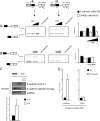Corepressor CtBP and nuclear speckle protein Pnn/DRS differentially modulate transcription and splicing of the E-cadherin gene
- PMID: 18086895
- PMCID: PMC2258767
- DOI: 10.1128/MCB.00421-07
Corepressor CtBP and nuclear speckle protein Pnn/DRS differentially modulate transcription and splicing of the E-cadherin gene
Abstract
CtBP is a transcriptional corepressor with tumorigenic potential that targets the promoter of the tumor suppressor gene E-cadherin. Pnn/DRS (Pnn) is a "nuclear speckle"-associated protein involved in mRNA processing as well as transcriptional regulation of E-cadherin via its binding to CtBP. Here, we show that CtBP can recruit Pnn to CtBP-associated complexes, resulting in Pnn-dependent chromatin remodeling at the E-cadherin promoter. In addition, CtBP and Pnn can differentially modulate E-cadherin mRNA splicing, with polymerase II serving as an interface in this event. Therefore, the Pnn/CtBP functional interplay represents a novel mechanism linking the corepressor CtBP and Pnn to the transcription-coupled mRNA splicing of a major tumor suppressor gene. Our findings implicate the existence of the molecular switches involved in tumorigenesis, which coordinate promoter-specific events and mRNA processing, by serving as bridging elements between the regulatory complexes both at gene promoters and within the mRNA splicing machineries.
Figures







Similar articles
-
Nuclear speckle-associated protein Pnn/DRS binds to the transcriptional corepressor CtBP and relieves CtBP-mediated repression of the E-cadherin gene.Mol Cell Biol. 2004 Dec;24(23):10223-35. doi: 10.1128/MCB.24.23.10223-10235.2004. Mol Cell Biol. 2004. PMID: 15542832 Free PMC article.
-
Interaction between Smad-interacting protein-1 and the corepressor C-terminal binding protein is dispensable for transcriptional repression of E-cadherin.J Biol Chem. 2003 Jul 11;278(28):26135-45. doi: 10.1074/jbc.M300597200. Epub 2003 Apr 24. J Biol Chem. 2003. PMID: 12714599
-
A novel corepressor, BCoR-L1, represses transcription through an interaction with CtBP.J Biol Chem. 2007 May 18;282(20):15248-57. doi: 10.1074/jbc.M700246200. Epub 2007 Mar 22. J Biol Chem. 2007. PMID: 17379597
-
Transcriptional regulation by C-terminal binding proteins.Int J Biochem Cell Biol. 2007;39(9):1593-607. doi: 10.1016/j.biocel.2007.01.025. Epub 2007 Feb 4. Int J Biochem Cell Biol. 2007. PMID: 17336131 Review.
-
The transcriptional corepressor CtBP: a foe of multiple tumor suppressors.Cancer Res. 2009 Feb 1;69(3):731-4. doi: 10.1158/0008-5472.CAN-08-3349. Epub 2009 Jan 20. Cancer Res. 2009. PMID: 19155295 Free PMC article. Review.
Cited by
-
Transcriptomic analysis of PNN- and ESRP1-regulated alternative pre-mRNA splicing in human corneal epithelial cells.Invest Ophthalmol Vis Sci. 2013 Jan 23;54(1):697-707. doi: 10.1167/iovs.12-10695. Invest Ophthalmol Vis Sci. 2013. PMID: 23299472 Free PMC article.
-
Pinin interacts with C-terminal binding proteins for RNA alternative splicing and epithelial cell identity of human ovarian cancer cells.Oncotarget. 2016 Mar 8;7(10):11397-411. doi: 10.18632/oncotarget.7242. Oncotarget. 2016. PMID: 26871283 Free PMC article.
-
PNN and KCNQ1OT1 Can Predict the Efficacy of Adjuvant Fluoropyrimidine-Based Chemotherapy in Colorectal Cancer Patients.Oncol Res. 2021 Mar 16;28(6):631-644. doi: 10.3727/096504020X16056983169118. Epub 2020 Nov 18. Oncol Res. 2021. PMID: 33208224 Free PMC article.
-
C-Terminus of E1A Binding Protein 1 Stimulates Malignant Phenotype in Human Hepatocellular Carcinoma.Med Sci Monit. 2019 Nov 17;25:8660-8670. doi: 10.12659/MSM.920114. Med Sci Monit. 2019. PMID: 31860631 Free PMC article.
-
Pinin associates with prognosis of hepatocellular carcinoma through promoting cell proliferation and suppressing glucose deprivation-induced apoptosis.Oncotarget. 2016 Jun 28;7(26):39694-39704. doi: 10.18632/oncotarget.9233. Oncotarget. 2016. PMID: 27175589 Free PMC article.
References
-
- Auboeuf, D., A. Honig, S. M. Berget, and B. W. O'Malley. 2002. Coordinate regulation of transcription and splicing by steroid receptor coregulators. Science 298416-419. - PubMed
-
- Balasubramanian, P., L. J. Zhao, and G. Chinnadurai. 2003. Nicotinamide adenine dinucleotide stimulates oligomerization, interaction with adenovirus E1A and an intrinsic dehydrogenase activity of CtBP. FEBS Lett. 537157-160. - PubMed
-
- Batsche, E., M. Yaniv, and C. Muchardt. 2006. The human SWI/SNF subunit Brm is a regulator of alternative splicing. Nat. Struct. Mol. Biol. 1322-29. - PubMed
Publication types
MeSH terms
Substances
Grants and funding
LinkOut - more resources
Full Text Sources
